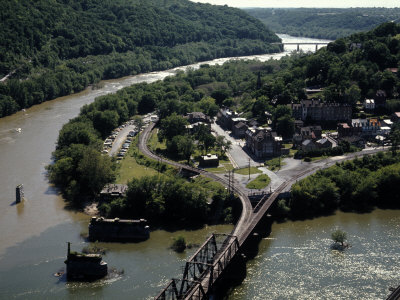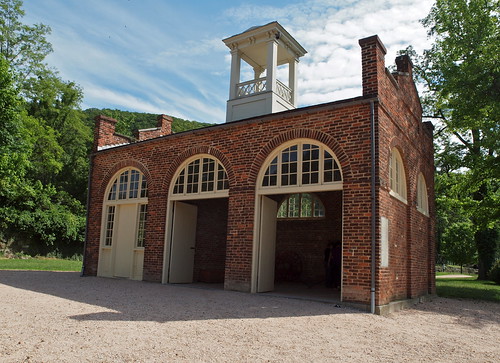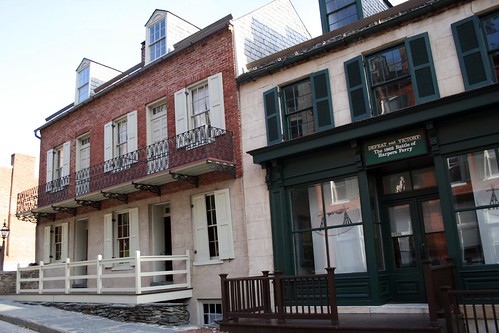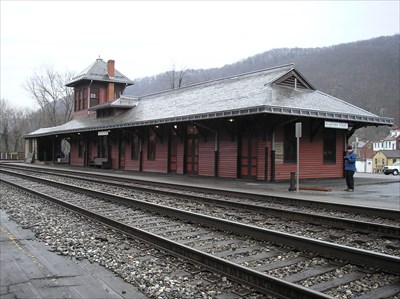
Located at the confluence of the Shenandoah and Potomac Rivers, the quaint village of Harpers Ferry, West Virginia was the site of crucial events in American history. Harpers Ferry National Historical Park helps preserve and interprets the historic town where pioneers, inventors, soldiers, townspeople, teachers, and civil rights leaders made their mark in this special place nestled in the Blue Ridge Mountains.


In 1747, Robert Harper, a millwright and builder enroute from Philadelphia to the Shenandoah Valley, crossed the Potomac River at a place called “The Hole.” Because of its location at the confluence of two major rivers, Harper immediately recognized the commercial, industrial, and transportation potential of this area and by 1751 purchased 125 acres from land baron Lord Fairfax. In the years that followed, Harper operated a ferry and erected a water-powered gristmill on the Shenandoah River. In 1763, the Virginia General Assembly established the town of “Shenandoah Falls at Mr. Harper’s Ferry.” In 1775, Harper started construction on a new home, which he did not live long enough to occupy, but his house still stands today and is the oldest surviving building in the Lower Town.

The site for the United States Armory and Arsenal at Harpers Ferry
In 1785, President George Washington selected Harpers Ferry as the site for the United States Armory and Arsenal. The potential waterpower of the two rivers impressed Washington, who felt that Harpers Ferry’s remote location would protect the armory from foreign invasion. The Federal Government purchased about 118 acres of land from John Wager, Sr. whose wife had inherited the property from Robert Harper. By 1798, construction began on the factory, dam, and a waterpower canal on the Potomac, followed by workshops, a barracks for armory workers, and a large brick building for storing the finished arms (the arsenal). In 1802, a substantial weapons production began, and the arsenal grew in the ensuing decades to include 20 workshops, two arsenal buildings, and 86 dwellings.

At the armory from 1819 until 1840, John H. Hall, a New England gun maker, pioneered mechanized arms production and interchangeable gunparts. At the time, skilled artisans made specific parts for individual weapons, which was time consuming and made the weapons difficult to repair. Hall revolutionized production methods, enabling the armory to manufacture more than 600,000 firearms from 1801 through 1860. In 1803, even Meriwether Lewis stocked up on weapons from the armory at Harpers Ferry before his transcontinental expedition. While much of the armory and arsenal were destroyed during the Civil War and later by flooding, visitors to the park can walk the grounds at Arsenal Square and near the train station where this important complex once stood.

For one man, the armory was the ideal place to take a stand against slavery in the United States. At the age of 59, abolitionist John Brown led an armed attack on the town of Harpers Ferry and the US Armory. Brown was very religious and had been a long time participant in anti-slavery campaigns. By the late 1850s, Brown conceived a plan to liberate slaves by starting a revolution. He hoped to arm the slaves and lead them against US forces in a rebellion to end slavery. Brown chose Harpers Ferry because of the 100,000 weapons stored at the US Armory and because here he would have access to slaves in the South, the mountains of Virginia as a stronghold, and the Free State of Pennsylvania for escape routes north.

Brown prepared for his raid all summer on the nearby Kennedy Farm. Ready to fight, Brown launched the raid on Sunday evening, October 16, 1859. His 21-man "army of liberation" seized the armory and several other strategic locations. On the morning of October 18, US Marines stormed the armory fire engine house with Brown and his men inside and captured Brown. Only 36 hours after the raid began, most of Brown’s men had been killed or wounded. Visitors can view the engine house, now known as John Brown’s Fort, and contemplate his raid and the legacy of the nation’s struggle with slavery.
After his capture, Brown was tried for treason and conspiring with slaves to rebel and commit murder, found guilty, and hanged in Charles Town, West Virginia on December 2, 1859. While Brown’s raid was short lived, it drew the nation’s attention to Harpers Ferry and to the issue of the morality of slavery in the United States. In his last words right before death, Brown predicted that civil war was looming, a prediction that came true less than two years later.

By 1861, Harpers Ferry found itself on the boundary between the Union and Confederate forces, which both viewed Harpers Ferry as strategically significant. During the Civil War, Harpers Ferry faced major destruction and changed hands between the North and the South no less than eight times. While visiting the park, visitors can walk around Maryland Heights and Bolivar Heights Battlefield, sites of major activity during the Civil War. Visitors can also walk around Camp Hill, the location of several armory residences used by both the Union and Confederate forces. At times during the war, runaway slaves, or “contraband,” sought refuge in Harpers Ferry. At the end of the war, with the passage of the 13th Amendment to the Constitution and the establishment of the Freedman’s Bureau, Harpers Ferry and the buildings on Camp Hill would again play a significant role in the lives of African Americans.

Following the Civil War, the Reverend Dr. Nathan Cook Brackett, representing the US Freedmen’s Bureau, established a primary school in the Lockwood House on Camp Hill for 19 recently freed black children. In 1867, New England Freewill Baptists missionaries acquired several vacant buildings on Camp Hill and established the “Storer Normal School.” Philanthropist John Storer of Sanford, Maine offered $10,000 to establish a freedman’s school in the Harpers Ferry area with the condition that the school match this donation within a year and admit students regardless of sex, race or religion. By 1869, the Federal Government transferred Lockwood House and three other armory residences on Camp Hill to the school’s trustees, and West Virginia granted the charter establishing Storer College. For 25 years, Storer College was the only school in West Virginia that offered African Americans an education beyond the primary level.

The Lockwood House, on Fillmore Street. The Lockwood House was the home of the U.S. Armory's Paymaster, and was later used by Storer College, a historically Black college.
Famous abolitionist and civil rights advocate Frederick Douglass served as one of the Storer College trustees, because he realized the school’s importance. During the 14th anniversary of the college at the dedication of Anthony Hall, Douglass gave a memorable speech on the subject of John Brown’s raid saying, “Did John Brown draw his sword against slavery and thereby lose his life in vain? And to this I answer ten thousand times, No! No man fails, or can fail, who so grandly gives himself and all he has to a righteous cause…”

Other civil rights advocates used Storer College as a place to discuss and combat the injustices against free African Americans. By the end of the 19th century and beginning of the 20th century, African Americans faced restrictions imposed by Jim Crow laws that made segregation legal. To combat these injustices, W.E.B. Du Bois and other leading civil rights advocates created the Niagara Movement and held their second conference (and first public meeting) at Storer College in 1906. The meeting, which welcomed women, included a pilgrimage to John Brown’s Fort, speeches, meetings, special addresses, and commemorative ceremonies. Visitors can learn more about Storer College and the Niagara Movement at the museum in Lower Town, by taking a guided tour of the campus, or by viewing the Storer College Room in the college’s main building, now the Mather Training Center.

Niagara Movement delegates, Harpers Ferry, W.Va., August 17, 1906.
Movement laid the foundation for the modern Civil Rights Movement, and while it dissolved in 1911, most of its members formed the backbone for the newly organized National Association for the Advancement of Colored People (NAACP). The NAACP would go on to bring the significant Brown v. Board of Education case to the Supreme Court in 1954. This landmark case ended school segregation by declaring it unconstitutional. This ruling ended Federal and State funding of Storer College, and when the financial burdens became too heavy, Storer College closed its doors in 1955. (source: The National Park Service)


I am interested in re-creating a Freedmans Home on my property here in Harpers Ferry. It originally had a small home on the property that was a Freedmans Home, it would be great to rebuild it and let people know how it looked.
ReplyDelete